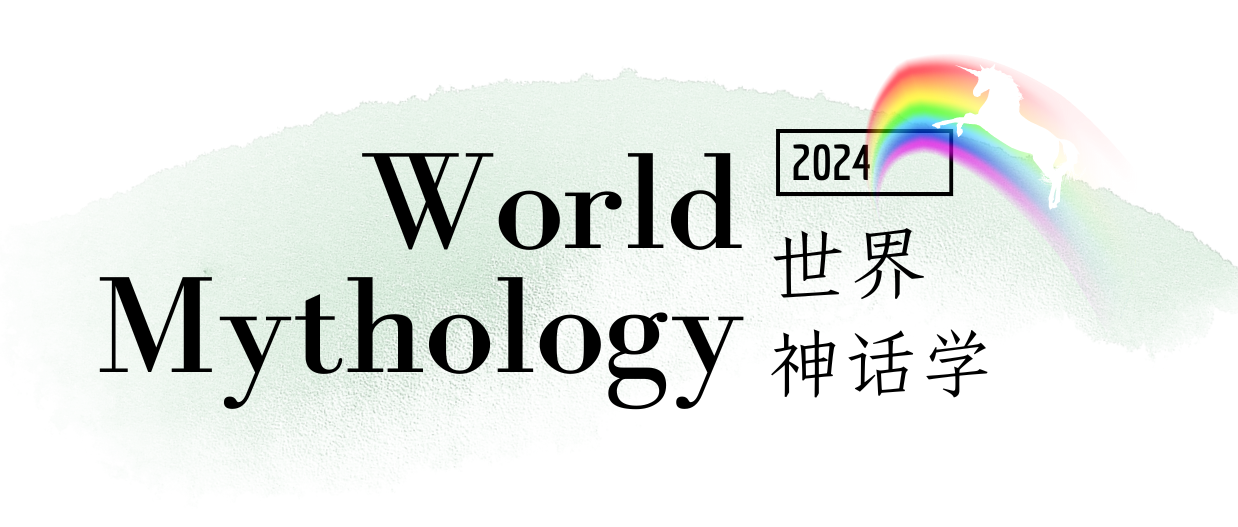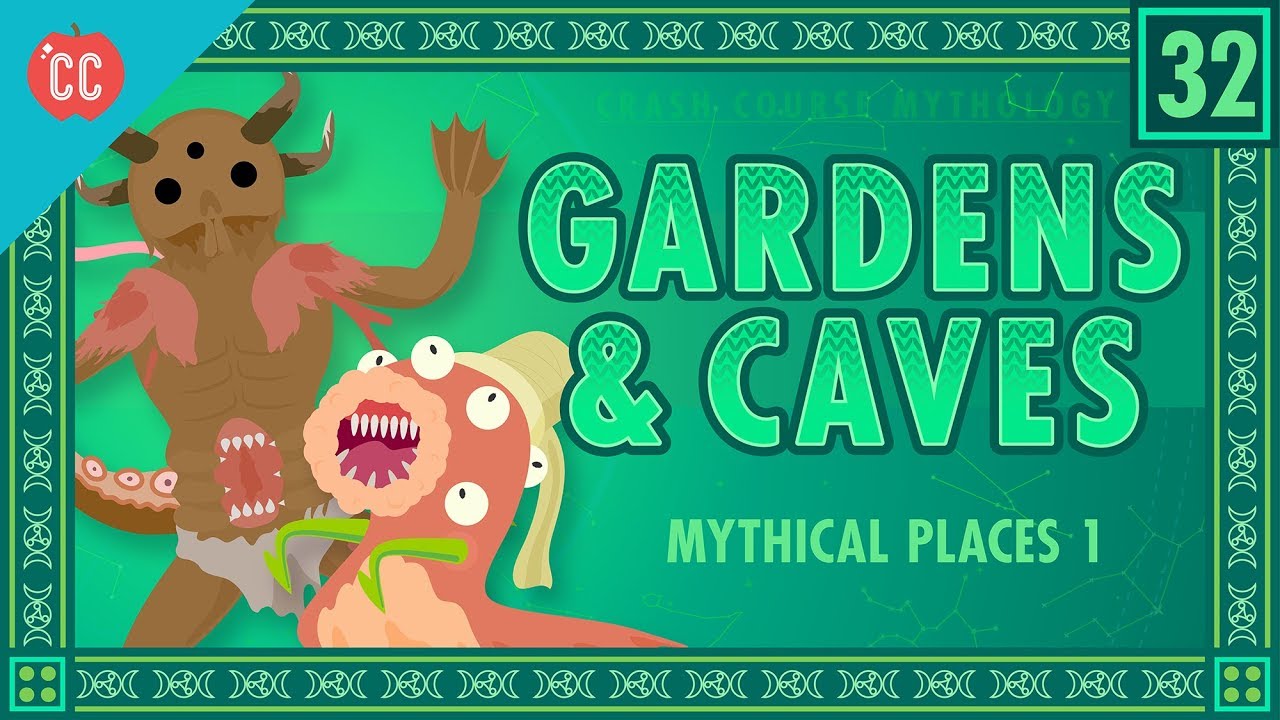
版权归Crash Course公开课所有,本文仅作读文学习使用,如侵权,请联系搬运工删除。
该本仅分段,未作精细校验,可能会出现单词错误,语义不详等问题。讲究读文体验的朋友也可等搬运工修订注释后再读。
(32)
Mythical Caves and Gardens

Description
🌳 This week, Mike Rugnetta is teaching you about mythical gardens and caves, which appear in cultures all over the world. Caves and gardens can stand for different things, but in the two stories we're talking about today, they tie into the creation of the world in general, and the origins of humans in particular.
🌳
1. This is Crash Course Mythology, and today we are going spelunking. Spelunking in the world of myth! Also, gardening in the world of myth. You know what they say: dress for the job you want, not the one you have.
Many myths take place outside of time and space. Remember 'without form and void?' But often, myths have specific meaningful settings. And over the next few episodes, we're going to to talk about some of the most important places where myths have happened.
🌳
2. According to scholars Lenard and McClure, there are many location-based tropes that repeat in myths from around the world. Sacred waters, caves, mountains, and there are mythic gardens and forests, too. Scholar David Leeming has also added cities and temples to the list.
Today we're going to look at two mythic settings side by side: the garden and the cave, which play complimentary roles in various stories of creation.
🌳
3. Considering that gods hate weeding, it's surprising how many myths involve gardens. We've discussed a few already, like the Garden of Eden or the Garden of the Hespirides, where the apples of immortality were kept.
Gardens come in different shapes and sizes; there are even stories of gardens inside caves. You can see this clearly in the Greek and Roman myths of the Underworld. Hades is a vast underground land; dark and shadowy, but it still has some lush garden features.
🌳
4. There are pomegranate trees that provide food for Persephone and grapes that tempt Tantalus. And yet, when Orpheus attempts to bring Eurydice out of Hades, he's described as bringing her up through the dark mouth of a cave.
Mythic gardens and caves often work as symbols, more than literal descriptions. And where the meaning of those symbols need to overlap, they do - sometimes in a way that's weird or otherworldly to those of us with firsthand experience of actual gardens and caves.
🌳
5. But this raises a question: what symbolic values do we associate with caves and gardens? To answer, let's turn to a pair of stories about the origin of humanity.
First up: the Garden. We already talked about this story in an earlier episode with Adam and Eve, and a sneaky serpent. Then we focused on the actions and relationships of these characters and how they set up a social order.
🌳
6. Now, we'll focus on how heavily rooted this story is in place: the idyllic Garden of Eden. We can talk about the Garden of Eden as both a physical setting and a metaphor. As a place, Eden is described as lush and growing. In addition to Adam and Eve, the place is overrun with nature and wildlife. "Livestock and creeping things and beasts of the earth according to their kinds."
Hey! Creeping things! We missed you guys.
🌳
7. Of all the fruit-bearing trees in the Garden, there are two that matter most: the tree of the knowledge of good and evil and the tree of eternal life. Enter the sneaky serpent, an attempt to lie to Yahweh, and you know the rest.
But more important than the physical features of Eden is its position as a paradise from which humans are expelled because of their disobedience and as a hopeful state we supposedly want to return to. Eden doesn't disappear, but humans never find a way past the angel with the flaming sword who's stationed at and blocking the entrance.
🌳
8. So the perfect image of the Garden helps tell the story of humanity's fall from a state of perfection to one of debasement. As mythology scholars Leonard and McClure put it, after their disobedience humans must live "in an ill world, marked by disharmony, broken relationships, suffering and death."
We can compare this story and the symbolism of the Garden with a creation myth from the Zuni people of the American West, which involves a very important cave. One inspired by the Grand Canyon. According to the Zuni, humanity wasn't expelled from a bright garden, but rather emerged from a system of dark, forbidding caves. Instead of paradise, these caves serve as a symbol for chaos. Let's take a look at the story.
🌳
9. Long ago, before humanity was fully formed, they all lived deep underground in dark chaos. No one could see each other. The humans have horns and tails, they have webbed fingers and toes, and lack some other features too. You'll see soon enough.
The sun sees humanity living in this state and sends his two sons, Younger Brother and Elder Brother, to help the people travel to the bright hills of the surface. Elder and Younger find the people in gross conditions. Stepping and spitting and urinating on each other.
🌳
10. So Elder and Younger plant trees. Pine, spruce, silver-spruce, and aspen, each representing one of the cardinal directions. As the brothers rise through the levels of the Under Realm, they drive a prayer stick from one of the trees into the earth.
This creates a sound like thunder that raises the people into each new world. The people are now on the surface, but they aren't fit enough for their new home. Elder and Younger give them corn, only to realize the people have no mouths.
🌳
11. So while the people sleep, the two sneak among them and cut mouths into their heads so they can eat. And luckily, the people love eating! Until another problem pops up. All that digested corn has nowhere to go. Younger realizes that none of these people have anuses.
So another round of sleepy-time surgery and everyone feels much relieved. Over the next days, Elder and Younger keep tweaking the humans; slicing their webbed hands so they can cook, chopping off their horns and tails, until at long last, humans are complete.
🌳
12. There are other versions of the Zuni myth where, after emerging from a spot in the Grand Canyon, the Zuni people set off in search of the Itiwana, or Middle Place, where they can achieve balance. On their journey, they stop at a number of sites that become sacred to the Zuni until finally settling at a spot near the headwaters of the Zuni River. All the sacred places are tied together by the rivers of the region.
But we're going to talk about sacred waters in a later episode. What's important for now is the role that caves play in the symbolism of this creation story. As a place of confusion, out of which humanity is guided.
🌳
13. Before comparing this cave of creation with the garden of Genesis, it's interesting to look at another image of the cave that has had profound influence on Western thinking and echoes the association of caves with immaturity or underdevelopment: Plato's Allegory of the Cave.
In his Republic, Plato describes a great cave as a way to explain why people wouldn't readily accept the wisdom of awesome philosophers like himself. He asks us to imagine a world in which humans are sitting in a dark cave, chained up so they can only face forward. Behind them, out of view, unseen agents parade a series of objects in front of a great light.
🌳
14. From where humanity sits, they can only see the shadows that flicker across the wall, cast by the real objects behind them. The shadows are their reality. Plato says, "Imagine that one of those chained viewers breaks free and makes his way out of the cave." Just like the Zuni, Plato's imaginary escapee is blinded by brightness of the world outside the cave.
Eventually his eyes adjust and things come into focus, but he still has difficulty believing that what he sees is real. But knowing about what's outside the cave, he runs back in to tell the others. When he tries to explain to them that what they think is reality is only a projection, people in the cave don't believe him.
🌳
15. Plato suggests that those chained up might even try to kill whoever got free. That person, who escapes the cave is, you guessed it, a philosopher pointing out to the rest of us that our reality is actually a pale reflection of a more true world.
Plato's cave and the Zuni emergence story are obviously very different. Only one involves the creation of the anus, for instance. But in both cases, the world of the cave is both physically and metaphorically dark. The cave is a position of ignorance or inability. And the surface represents enlightenment, figuratively and literally.
🌳
16. One could even say that the emergence leads to humanity reaching a more perfect state. As Leonard and McClure put it, "In the Zuni tale... humans existed in a dark, imperfect world...at the calling of Father Sun, they emerged from this dark chaos into a world of light and healthy relationships and harmony with their fellow inhabitants..."
This is a stark contrast to the creation story in Genesis, where human beings, having been created by god, begin as perfect beings and then are forced into a state of imperfection when ejected from the Garden like the heathenous revellers they are.
🌳
17. The story of humanity isn't only a story of a fall, but a quest to return - to reenter paradise. Obviously, in the Zuni story, no one is clamoring to get back into the cave of no anus. We can ask then, whether these inverted orientations regarding creation make a difference in their respective cultures.
Do you go about your day differently depending upon whether you think of the Earth as a place of punishment for leaving a perfect garden versus as a garden itself, a reward for making it out of the dark cave of chaos.
🌳
18. Next week, we're going to stick with our mythical settings and head for the hills to talk about magical mountains.
Thanks for watching. We'll see you next time! And while you might think endless soup salad and bread sticks must be a myth, that garden is for real.
To be continued…
未完待续…

